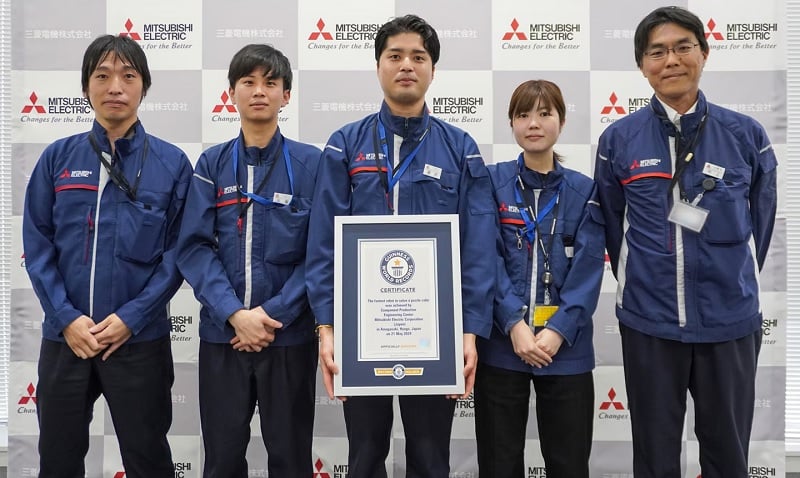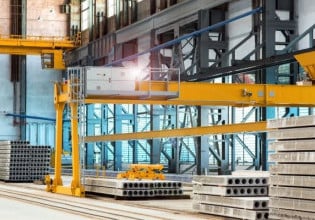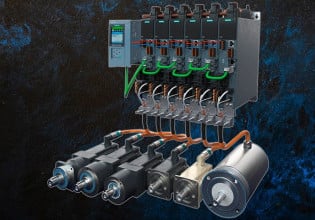What Can You Do in 0.305 Seconds? Mitsubishi Set a World Record
Don’t blink — you might miss the new speed record set by a Mitsubishi robot when solving a Rubik’s Cube, an achievement verified by the Guinness World Records administration.
Robots have always been fast at performing predictable, consistent motions, but the magnitude of one recent program has been nothing short of record-breaking! A Mitsubishi robot called TOKUI Fast Accurate Synchronized Motion Testing Robot, or TOKUFASTbot, has just been awarded a world record for the shortest time to solve the legendary Rubik’s Cube.
Despite having such a long name, this robot was able to solve the well-known puzzle in just 0.305 seconds!

A Mitsubishi servo-driven robotics assembly solved the Rubik’s Cube in just 0.305 seconds! Image used courtesy of Mitsubishi Factory Automation
Complex Motion Controls
Some numbers are difficult for us humans to comprehend. Sure, we have prefixes for numbers like mega, giga, milli, and micro, but if you ever stop to think about the sheer size of these numbers, it can leave you in awe of just how far technology has advanced on both large and small scales.
In order to solve a puzzle like the Rubik’s Cube in such a short time, there must be some incredible power and precision behind the rotary joints that spin the cube segments. This is truly a testament to Mitsubishi’s motion control hardware.
Before diving into the technical specifics of a project like this, take a look at the video that shows the real-time view of the puzzle solution, followed by the super slow-mo version that gives you the assurance that it did, indeed, solve the cube by actual motion commands. No video editing here, just good old industrial hardware!
Video used courtesy of Mitsubishi Electric- Global
Motion Hardware
Motion is the sole job of motors, and in this case, precision at that speed can only be accomplished with servo motors, where the encoder is connected to the motor, providing live feedback about the position.
But there’s more to the challenge than just the motors. When the command is issued, it is sent to a driver, which directly outputs the current to motors and then waits for the signal to be returned from the encoder. If there are any delays in the communication, the motion, the feedback, or even in the control algorithm, each individual motion will take longer.
The design of these servo motors allows a 90° rotation in just 0.009 seconds, less than 1/100 of a second for a quarter of a rotation to occur. To throw down some industrial rotation numbers, this roughly equates to 1650 RPM for the motor, which isn’t exactly a massive shock to control engineers.
However, what IS truly remarkable is that the acceleration and deceleration profile (as well as the settling time) for this ¼ of one revolution have all been completed within that average velocity time.

The winning development team! Image used courtesy of Mitsubishi Factory Automation
Vision Sensing and Algorithms
Before the motion begins, there is a bit of programming that must take place. Just like a human puzzle operator might examine the different squares and predict a plan of attack, the computer must follow the same plan.
AI technology has been employed in this instance to plan the motion. However, one benefit that robots have over (most) humans is the ability to rotate two opposite sides of the cube simultaneously. Most people will perform one action at a time. They might be fast, but the ability to make two unique motions to opposite sides of the cube without affecting or conflicting with the other side is rare.
Implications for Engineers
As always, we strive to extract what this means for control engineers. Perhaps solving a Rubik’s Cube isn’t in your company’s goals for Q3 of 2024, but faster production with fewer mistakes is certainly high on the priority list!
Mitsubishi continues to make strides in advancing the speed and precision of motion technology, and demonstrations like this serve to underscore the achievements in terms that people can more easily understand, and for that, we salute them.
Well done, you little puzzle-solving robot!






